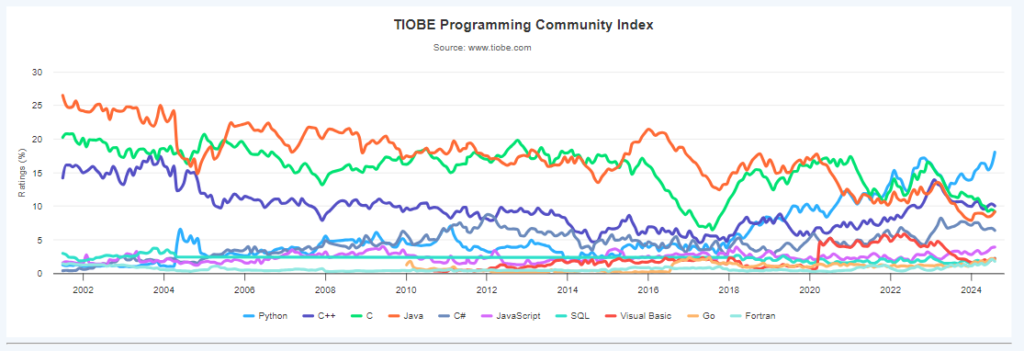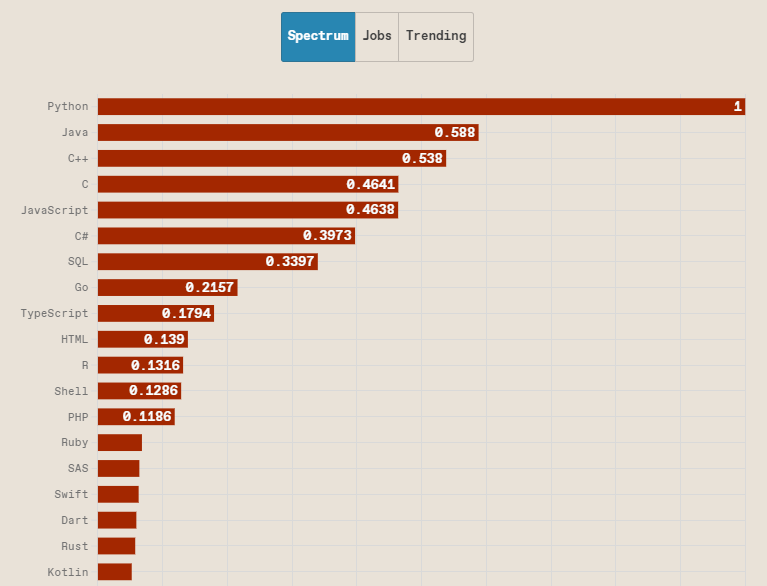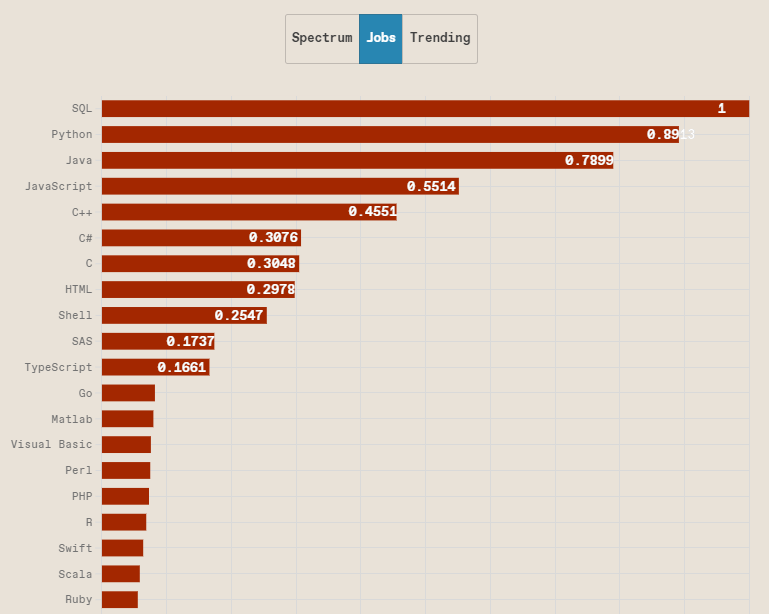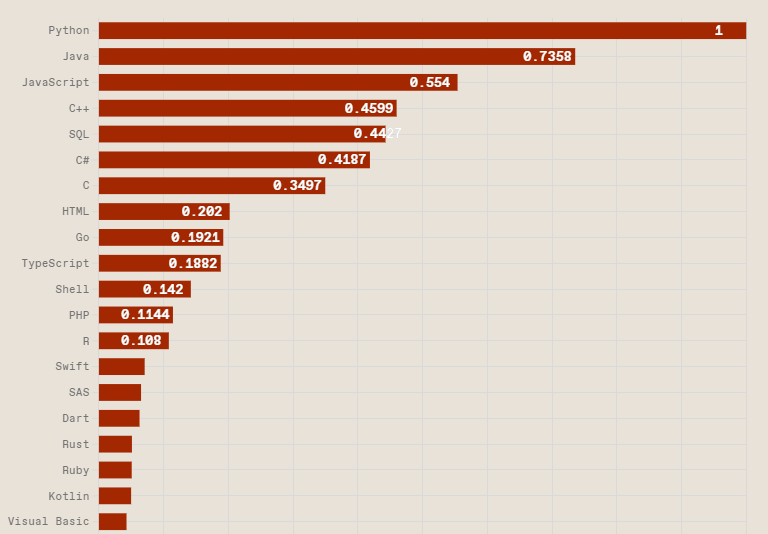People are increasingly drawn to and curious about coding. However, selecting the right programming language can be challenging due to the scattered or limited information available.
To simplify the decision-making process, it’s helpful to understand “The Programming Index.” This index can help you assess whether your programming skills are up-to-date with the current market trends. It can also guide you in making strategic decisions about which programming language to learn or adopt.
Measures of Programming Language!
Programming languages are measured using various parameters, and many resources online rank them differently. These rankings often reflect different biases depending on the criteria used. Some of the common factors include:
- Frequency of the language’s name in web searches
- Simplicity of the language
- Availability of programming jobs requiring the language
- Number of projects using the language on platforms like SourceForge and GitHub
- Sales of books that teach or describe the language
For reliable programming language rankings, consider checking these sources:
- TIOBE Programming Community
- PYPL PopularitY of Programming Language
- IEEE Spectrum Ranking
- Redmonk Ranking
Now, let’s dive into what these rankings reveal…
TIOBE (The Importance Of Being Earnest) Index
The TIOBE index is not intended to determine the best programming language or the one with the most lines of code written. Instead, it aims to reflect the popularity of programming languages based on the number of web pages that mention them, which can be an indicator of the number of skilled engineers, courses, and job opportunities worldwide.
TIOBE Community Index
The TIOBE ratings are calculated by counting the hits on popular search engines. The search query used for this calculation is: +"<language> programming".
It’s important to note that the TIOBE index does not rank languages based on their quality or the volume of code written in them.
Search Engines
The index is derived from 25 search engines, including Google, Google Blogs, MSN, Yahoo, Baidu, and others. It is updated monthly to provide the latest insights.
Requirements for Inclusion in the TIOBE Index
To qualify for the TIOBE Index, a programming language must meet the following three criteria:
Wikipedia Entry: The language must have its own entry on Wikipedia, clearly stating that it is a programming language. This is why technologies like (Ruby on) Rails, Excel, Android, Boost, Cocoa, ASP, and AJAX are not included in the index.
Turing Completeness: The language must be Turing complete. Therefore, languages like HTML and XML are excluded as they do not meet this criterion.
5,000+ Google Hits: The language must generate at least 5,000 hits for the query
+"<language> programming"on Google.
TIOBE Index: Top 20 Programming Languages
| Aug 2024 | Aug 2023 | Change | Programming Language | Ratings | Change | |
|---|---|---|---|---|---|---|
| 1 | 1 |  | Python | 18.04% | +4.71% | |
| 2 | 3 |  |  | C++ | 10.04% | -0.59% |
| 3 | 2 |  |  | C | 9.17% | -2.24% |
| 4 | 4 |  | Java | 9.16% | -1.16% | |
| 5 | 5 |  | C# | 6.39% | -0.65% | |
| 6 | 6 |  | JavaScript | 3.91% | +0.62% | |
| 7 | 8 |  |  | SQL | 2.21% | +0.68% |
| 8 | 7 |  |  | Visual Basic | 2.18% | -0.45% |
| 9 | 12 |  |  | Go | 2.03% | +0.87% |
| 10 | 14 |  |  | Fortran | 1.79% | +0.75% |
| 11 | 13 |  |  | MATLAB | 1.72% | +0.67% |
| 12 | 23 |  |  | Delphi/Object Pascal | 1.63% | +0.83% |
| 13 | 10 |  |  | PHP | 1.46% | +0.19% |
| 14 | 19 |  |  | Rust | 1.28% | +0.39% |
| 15 | 17 |  |  | Ruby | 1.28% | +0.37% |
| 16 | 18 |  |  | Swift | 1.28% | +0.37% |
| 17 | 9 |  |  | Assembly language | 1.21% | -0.13% |
| 18 | 27 |  |  | Kotlin | 1.13% | +0.44% |
| 19 | 16 |  |  | R | 1.11% | +0.19% |
| 20 | 11 |  |  | Scratch | 1.09% | -0.13% |

PYPL (PopularitY of Programming Language) Index
The PYPL PopularitY of Programming Language Index is a ranking system that measures the popularity of programming languages by analyzing how frequently language tutorials are searched on Google. The data for this index is derived from Google Trends, which tracks the search volume of specific queries over time.
The PYPL index is particularly useful for those trying to decide which programming language to learn or use in a new software project. By focusing on the frequency of tutorial searches, the index reflects the current interest and demand for different languages in the developer community.
This can be a valuable indicator of which languages are gaining traction and which ones might be declining in relevance.
In addition to helping developers make decisions, the PYPL index also offers insights into industry trends, highlighting emerging languages that are gaining popularity. Because it relies on real-time search data, the index is continually updated, providing a dynamic view of programming language trends as they evolve.
Whether you’re a beginner looking to choose your first programming language, or an experienced developer considering expanding your skill set, the PYPL index is a helpful resource for making data-driven decisions.
PYPL Index: Top 28 Programming Languages
| Rank | Change | Language | Share | 1-year trend |
|---|---|---|---|---|
| 1 | Python | 29.6 % | +1.7 % | |
| 2 | Java | 15.51 % | -0.3 % | |
| 3 | JavaScript | 8.38 % | -1.0 % | |
| 4 | C# | 6.7 % | -0.0 % | |
| 5 | C/C++ | 6.31 % | -0.2 % | |
| 6 |  | R | 4.6 % | +0.2 % |
| 7 |  | PHP | 4.35 % | -0.6 % |
| 8 | TypeScript | 2.93 % | -0.1 % | |
| 9 | Swift | 2.76 % | +0.1 % | |
| 10 |  | Rust | 2.58 % | +0.5 % |
| 11 |  | Objective-C | 2.4 % | +0.2 % |
| 12 | Go | 2.14 % | +0.2 % | |
| 13 | Kotlin | 1.94 % | +0.2 % | |
| 14 | Matlab | 1.5 % | -0.0 % | |
| 15 |     | Powershell | 1.01 % | +0.1 % |
| 16 |  | VBA | 1.0 % | +0.0 % |
| 17 |  | Dart | 0.99 % | +0.0 % |
| 18 |    | Ruby | 0.96 % | -0.1 % |
| 19 |    | Ada | 0.96 % | -0.1 % |
| 20 |    | Lua | 0.72 % | +0.1 % |
| 21 |  | Scala | 0.6 % | -0.1 % |
| 22 | Abap | 0.57 % | -0.0 % | |
| 23 |   | Visual Basic | 0.46 % | -0.2 % |
| 24 |  | Groovy | 0.27 % | -0.1 % |
| 25 |  | Julia | 0.26 % | -0.1 % |
| 26 |  | Cobol | 0.19 % | -0.1 % |
| 27 |  | Perl | 0.14 % | -0.2 % |
| 28 | Haskell | 0.1 % | -0.1 % |
IEEE Spectrum Ranking
The IEEE Spectrum ranking starts with data on over 300 programming languages, drawing information from multiple sources like GitHub, Google Search, Google Trends, Twitter, Stack Overflow, Reddit, Hacker News, Career Builder, Dice.com, and the IEEE Xplore Digital Library.
What sets this ranking apart is its highly personalized approach. The interactive interface allows users to filter results based on different dimensions such as search trends, job availability, or the strength of the open-source community.
You can also customize the weight of each factor, creating a tailored ranking that best fits your specific needs and preferences. IEEE Ranking.
Top Programming Languages by Spectrum, Jobs, and Trending



Moving Forward…
Based on current trends, I recommend starting with C/C++ as a solid foundation before exploring future technologies like Artificial Intelligence (AI), Machine Learning (ML), and Deep Learning.
These are broad fields, but you can begin by learning Python, which is simple, practical, and the most in-demand language right now. A basic guide on Python programming could be a great place to start.
If you want to start your career in data analytics then SAS programming can be your best friend. Here’s the completely free guide to learn SAS programming.
Good luck, and happy coding!
References: